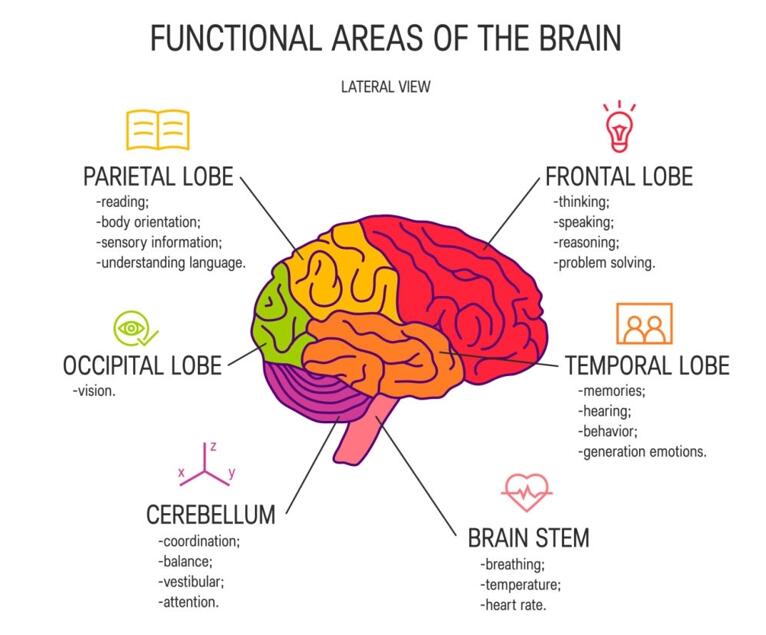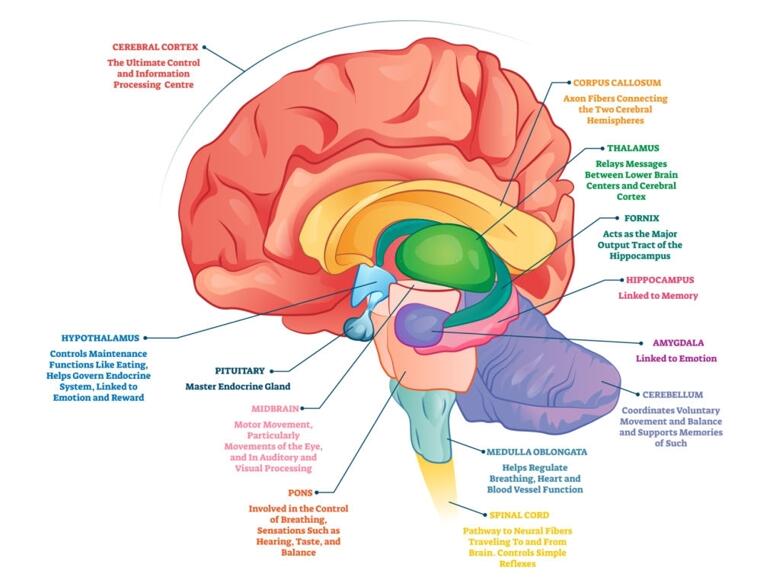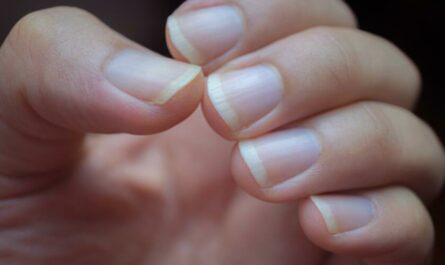The human brain is one of the most complex and fascinating organs in the body. It is responsible for controlling every aspect of our lives, including our thoughts, emotions, and actions. The brain is made up of several different parts, each with its own unique function and purpose. Understanding the different parts of the brain is essential to understanding how it works and how it can be affected by injury or disease. In this article, we will explore the different parts of the brain and their functions.
Parts of the Brain: Structures and Their Functions
The brain is a 3-pound organ with over 100 billion neurons and many specialized areas. There are 3 main parts of the brain include the cerebrum, cerebellum, and brain stem.
The Cerebrum can also be divided into 4 lobes: frontal lobes, parietal lobes, temporal lobes, and occipital lobes. The brain stem has three major parts: Midbrain, Pons, and Medulla oblongata. Although each structure has a distinct function, they work together to control all body functions.

1. Cerebrum
The cerebrum is the largest part of the human brain. It has a rough surface (cerebral cortex) with gyri and sulci. It can also be divided into 2 parts: the left hemisphere and the right hemisphere.
Although the hemispheres look identical, the left and right hemispheres have particular functions. While the left hemisphere (logical side) controls language and speech, the right hemisphere (creative side) translates visual information.
According to the function, the cerebrum is further divided into 4 different lobes: frontal lobes, parietal lobes, temporal lobes, and occipital lobes. Each lobe has different functions:
Frontal Lobe
The frontal lobe rests just below the forehead and controls our reasoning, organizing, our ability to speak, solve problems, pay attention, and our emotions.
Parietal Lobe
The parietal lobe lies at the upper rear of our brain. This lobe manages our complex behaviors, including the 5 senses: touch, vision, and spatial awareness.
The parietal lobe also relays sensory information from different body parts, helps us process and learn a language, and maintains the body’s positioning and movement.
Occipital Lobe
The occipital lobe is located at the rear of our brain. This lobe is responsible for our visual awareness, including visual attention, optical recognition, and spatial awareness.
It also controls our ability to interpret body languages like facial expressions, gestures, and body postures.
Temporal Lobe
Your temporal lobe sits close to your ears and is associated with interpreting and translating auditory stimuli. For example, your temporal lobe allows you to focus on one voice at a loud party.
This lobe also helps you understand oral language and general process knowledge and stores your verbal and visual memory.
2. Cerebellum
The cerebellum, also known as the little brain, is located in the back of the brain. It sits just below the occipital lobes and on top of the pons. Just like the cerebrum, the cerebellum has two equal hemispheres and a wrinkly surface.
Although the cerebellum is small, it contains numerous neurons. It can help coordinate the movement of body muscles, especially the fine movement of hands and feet. The function of the cerebellum also includes maintaining posture, equilibrium, body balance, and even speech.
3. Brainstem
The brain stem is the posterior part of the brain that connects the brain with the spinal cord. Brain stem works together to regulate essential life functions, including body temperature, breathing, heartbeat, and blood pressure.
In addition, the brain stem coordinates the fine movement of the face and limbs. Functions of this area include sneezing, vomiting, swallowing, and movement of the eyes and mouth.
The brain stem comprises parts of the midbrain, pons, and medulla, all with specific functions.
Midbrain
The midbrain consists of the tegmentum and the tectum, located in the mouth of the brain stem. It plays a key role in controlling voluntary motor function and transferring messages. In addition, it controls eye movement and processes auditory and visual information, and eye movement.
Pons
The pons is the largest structure in the brain stem and is found above the medulla and underneath the midbrain, and in front of the cerebellum. It functions as a bridge between several parts of the nervous system, including the cerebrum and cerebellum. The pons also contains many vital nerves, such as
- The trigeminal nerve – This nerve controls facial muscles involved in chewing, biting, and swallowing.
- The abducens nerve – The abducens nerve allows the eyes to look from side to side.
- The vestibulocochlear nerve – This nerve controls hearing and balance.
The pons also helps regulate sleep cycles, breathing patterns, respiration, and reflexes.
Medulla
The medulla is a cone-shaped structure located in front of the cerebellum. The prominent role of the medulla oblongata is regulating involuntary (autonomic) functions, including breathing, digestion, sneezing, swallowing, and heart rate.
4. Limbic System
The limbic system is a complex brain structure that lies deep in the cerebrum. It contains the thalamus, hypothalamus, hippocampus, and amygdala.
Since it plays a significant role in controlling our emotions and forming our memories, it is often called our “emotional brain” or ‘childish brain.’
Thalamus
The thalamus is a small mass of grey matter that relays sensory information from the spinal cord, brainstem, and other parts of the brain to the cerebral cortex.
The thalamus is a relay station for signals received by the human body from the outside to enter the brain. In addition, it is also related to consciousness, memory, and sleep.
Hypothalamus
The hypothalamus is a part of the brain that sits right below the thalamus. Although the hypothalamus is a tiny part of the brain, it has one of the most crucial and busiest roles.
The primary function of the hypothalamus is maintaining homeostasis in the body. It’s also responsible for releasing hormones, regulating body temperature, controlling appetite, and managing sexual behavior.
Amygdala
The amygdala is a small, almond-shaped structure in the limbic system that processes strong emotions like fear, aggression, and anxiety.
The amygdala is located close to the hippocampus. It contains many receptor sites that can also perceive certain emotions and the storing and retrieving of emotional memories.
Hippocampus
The principal role of the hippocampus is forming, organizing, and storing short and long-term memories.
The hippocampus also helps form new memories and links emotions, feelings, and sensations, such as specific smells and sounds, to these memories.
Pituitary Gland
The pituitary gland is a small, pea-shaped gland located at the brain’s base, just behind the bridge of the nose. The pituitary gland produces different hormones that regulate many of the body’s processes, including growth, sexual development, metabolism, and reproduction.
5. Skull
The skull is a fusion of bones that protects the brain and the brainstem and outlines the face. The 8 bones that protect your bones from injury include:
- 1 frontal bone
- 2 parietal bones
- 1 occipital bone
- 2 temporal bones
- 1 sphenoid bone
- 1 Ethmoid bone
Other Parts of the Brain
Meninges
Meninges are the three membranes that cover the brain and spinal cord and protect them from damage. The outermost layer is the dura mater, which is tough and resilient and helps to keep the brain and spinal cord in place.
The middle layer is the arachnoid mater, a delicate web of tissue that absorbs shocks and cushions the brain and spinal cord.
The innermost layer is the pia mater, which is a thin, transparent membrane that covers the brain and spinal cord.
Nerves
The brain is a complex organ, and the 12 cranial nerves help control the body’s functions. These nerves are responsible for sending messages through the body, helping to control the five senses, facial expressions, and movement.
- Olfactory Nerve: responsible for the sense of smell
- Optic Nerve: responsible for vision
- Oculomotor Nerve: responsible for eye movement and pupil constriction
- Trochlear Nerve: responsible for controlling eye movement
- Trigeminal Nerve: responsible for transmitting sensory information from the face, mouth, and nose
- Abducens Nerve: responsible for eye movement
- Facial Nerve: responsible for facial expressions and taste sensation
- Vestibulocochlear Nerve: responsible for hearing and balance
- Glossopharyngeal Nerve: responsible for a taste sensation and saliva secretion
- Vagus Nerve: responsible for controlling the involuntary muscles of the throat, lungs, and heart
- Accessory Nerve: responsible for controlling movement of the shoulder, neck, and head
- Hypoglossal Nerve: responsible for controlling the tongue muscles

Brain Conditions When the Brains Structure is Damaged
Your brain is one of the most complex organs in the human, and if one of the brain’s structures is damaged, it could lead to a brain condition.
For example, if your Broca’s area is damaged, you may have trouble moving your tongue, and your speech may be slow and poorly articulated. Other conditions that could affect the brain include:
Brain aneurysm: When an artery in the brain swells, it could lead to a brain aneurysm. If the aneurysm ruptures, it could cause a stroke.
Brain tumor: When any tissue in your brain starts growing abnormally, it could be a symptom of benign or malignant cancer.
Intracerebral hemorrhage: Bleeding inside the brain can cause difficulty speaking or difficulty walking.
Concussion: When there’s a heavy blow to the head, you may experience a concussion and temporarily lose brain function.
Cerebral edema: Electrolyte imbalance in the brain could lead to swelling of the brain tissue.
Glioblastoma: Glioblastoma is a brain tumor that develops rapidly and creates pressure on the brain.
Pro tip: Glioblastoma is usually aggressive and could be very difficult to cure.
Meningitis: When the lining around the brain or spinal cord becomes inflamed from an infection, you may have meningitis. Other symptoms associated with meningitis include; headache, fever, sleepiness, neck pain, and stiff neck.
Encephalitis: Encephalitis usually arises when tissue in the brain becomes inflamed. It’s usually a result of a viral infection and could cause fever, headache, and confusion.
Traumatic brain injury: A severe head injury could lead to permanent brain damage. Other symptoms include mental impairment and personality and mood changes.
Parkinson’s disease: Degeneration of nerves in the brain could lead to the development of Parkinson’s disease. People with Parkinson’s disease may experience hand tremors and problems with their coordination and movement.
Epilepsy: Although there’s no exact cause for epilepsy, head injuries, and several strokes can trigger epilepsy. People with epilepsy may also experience seizures.
Dementia: When a nerve cell in the brain starts malfunctioning or degenerating slowly, it could lead to dementia. Strokes and alcohol abuse could also cause brain dementia.
Alzheimer’s disease: Alzheimer’s disease is known as senile dementia. Here, the nerves in the brain degenerate, causing progressive dementia.
Brain abscess: A brain abscess occurs when there’s a pocket of infection in the brain. Brain abscesses are usually caused by bacteria and may require either antibiotics or surgical removal.
How to maintain a healthy brain?
Maintaining a healthy brain is crucial for overall physical and mental well-being. Here are some tips for keeping your brain healthy:
- Exercise regularly: Exercise is not only good for your physical health, but it is also essential for your brain health. It increases blood flow to the brain, which helps nourish brain cells and keep them healthy.
- Eat a healthy diet: A balanced and nutritious diet is essential for maintaining a healthy brain. Eat foods that are rich in omega-3 fatty acids, antioxidants, and vitamins, as these nutrients have been shown to improve brain function.
- Get enough sleep: Sleep is essential for brain health, as it helps consolidate memories and refreshes the brain. Make sure to get enough sleep each night, which is around 7-8 hours for most adults.
- Challenge your brain: Engaging in mentally stimulating activities can help keep your brain sharp. Try activities such as puzzles, reading, or learning a new skill to challenge your brain.
- Manage stress: Chronic stress can have negative effects on brain health. Practice stress management techniques such as meditation, deep breathing, or yoga to help manage stress.
- Stay socially active: Socializing and connecting with others can help maintain brain health. Join clubs, volunteer, or participate in activities that involve interacting with others.
By following these tips, you can help maintain a healthy brain and improve your overall well-being.






